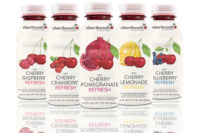Traditionally known for its skin-soothing benefits, aloe vera can be found in a multitude of consumer packaged goods (CPG) products, including tissues, soaps and lotions. It’s even being infused into items like bed sheets and socks. However, all of these applications revolve around the topical application of aloe vera. When it comes to the oral consumption of aloe vera, additional benefits come into play, thereby making it a trendy ingredient in functional beverages.
Last year, more than 225 beverages containing aloe vera were launched in various locations around the world, according to Chicago-based Mintel’s Global New Products Database (GNPD). This marks a 7 percent increase compared with tracked launches in 2012. However, only 10 of the aloe drinks launched in 2013 were released in the United States, which denotes a 52 percent decrease from the previous year, according to GNPD data.
Aloe vera drinks have been popular internationally, showcasing steady growth for many years, says Mick Anderson, director of sales for Terry Laboratories, Melbourne, Fla. In particular, the segment has performed well in Asia and Europe but still is emerging in the United States, notes Jeff Barrie, eastern regional sales manager for Aloecorp, Seattle. In recent years, however, an influx of single-serve aloe vera drinks from Asia has hit the U.S. market, he says.
For instance, SPI West Port Inc.'s Alo Drink offers a line of aloe vera juices with aloe vera pulp that comes from Thailand and Taiwan, the San Francisco-based company says. Dollar sales for the brand increased 24 percent for the 52 weeks ending Oct. 26, 2013, in all U.S. grocery stores except Whole Foods Market, making it the top-selling brand within the aloe vera beverage segment and the No. 2 best-selling brand within the functional beverage segment, says SPI West Port, citing data from Spins, Schaumburg, Ill. In comparison, the entire aloe vera beverage segment increased nearly 34 percent during the timeframe within the channel, it reports. Furthermore, shelf-stable, bottled aloe vera juices increased 17 percent in dollar sales for the 52 weeks ending Nov. 3 in supermarkets, drug stores, mass market retailers, gas and convenience stores, military commissaries, and select club and dollar retail chains, according to Information Resources Inc. (IRI), a Chicago-based market research firm.
This suggests that although aloe vera beverage launches decreased in the United States last year, the segment as a whole is growing. And while Aloecorp’s Barrie expects aloe vera juices to continue growing, he says the next phase will be beverage-makers incorporating aloe vera as a supplementary ingredient into healthy beverages, such as tea, sparkling water, flavored water and juice.
Food for function
According to the International Aloe Science Council (IASC), the primary component of the aloe vera plant is the leaf, which can be processed in two ways to make aloe vera juice. The juice also can be converted to powder or concentrated.
Incorporating aloe vera into a beverage application can present a vegetable-like odor and taste as well as light coloring; however, its health benefits are what draw in consumers, notes Terry Laboratories’ Anderson. In fact, top new product development teams and executives rank aloe as one of the Top 10 most important ingredients for skin and overall digestive wellbeing, according to the IASC, he says.
“While no claims are intended to be made, there have been good, legitimate scientific studies to indicate that aloe can be helpful with gastrointestinal disorders,” Anderson says. “Higher molecular weight polysaccharides found in aloe vera has been beneficial for the immune system.”
For instance, as a result of a single-center, randomized, double-blind, placebo-controlled human clinical study using Aloecorp’s Qmatrix ACTIValoe, the Korean Food and Drug Administration (KFDA) concluded that functional health foods containing aloe taken orally support immune function. Additionally, another study affirmed by the KFDA found that daily consumption of functional health foods containing 1.2 grams of aloe taken orally showed significant positive clinical indexes of skin aging with reduction of wrinkles and increased skin elasticity. A third study also determined that Aloecorp’s Qmatrix ACTIValoe helps maintain health through management of cholesterol in the normal range and reducing oxidative stress status.
Aloe also has been shown to stimulate the body’s antioxidant system, Barrie adds.
“We’re hearing a lot about antioxidants these days, and we say aloe is an antioxidant, but really what it does is it stimulates your own antioxidant system,” he explains. “There’s [also] a lot of people that say they drink it for the anti-inflammatory benefit of it, but I think [the] No. 1 [reason they drink it] is the digestive health.”
Terry Laboratories’ Anderson also notes that a study funded by the IASC and conducted by Joe Vinson, Ph.D., of the University of Scranton in Pennsylvania found that the bioavailability, or absorption rate, of vitamins C and E were significantly increased when the vitamins were taken with aloe vera instead of water.
“There are a number of other benefits derived by consuming aloe,” he says. “There is no question that, among the over 200 compounds found in aloe vera, the polysaccharides and, particularly, the molecular weight distribution of those polysaccharides, play a major role in the bio-communication and benefits derived.”
Therefore, Terry Laboratories spent 18 months improving its processing of aloe vera to develop its NaturLock System Aloe Vera Gel 1X, NaturLock System Aloe Vera Gel Concentrate 10X and NaturLock System Aloe Vera Gel Spray Dried Powder 200X products, which mimic the molecular weight distribution of that found in nature, he says. The company also offers a free high-performance liquid chromatography-size exclusion chromatography (HPLC-SEC) analysis of any aloe vera raw material to compare its total polysaccharide and molecular weight distribution with what is found in nature as well as with NaturLock System products, he notes.
To ensure that it retains as much of the poly-saccharides as possible, Aloecorp guarantees that its ACTIValoe brand of ingredients will have at least
10 percent polysaccharides by weight, Barrie says.
Easing into solution
Available in both liquid and powder forms, aloe vera generally is easy to incorporate into beverage applications, suppliers say.
Because aloe vera gel is 99.5 percent water, it can be incorporated easily into most water-phase product batches, Terry Laboratories’ Anderson says.
Concentrated powder formats also work well in aqueous solutions, Aloecorp’s Barrie adds. In fact, its customers request aloe vera in a powder format most often, he notes.
“The beauty of the powder is it’s easy to ship [and] it’s easy to store, but as a formulator, what’s great about it is there’s no preservatives in it,” he says. “There’s no fillers; there’s nothing added to it. The powders are pure aloe vera solids. [It’s] very easy to work with and goes right into solution … and you get all the benefits from aloe.”
Additionally, because the powder can be significantly concentrated — Aloecorp offers a 200-to-1 dried powder concentrate — only a small amount is needed in a beverage, and it will not affect the color or taste of the product much, he says.
Although every ingredient has its challenges, aloe vera suppliers note that there aren’t many cases in which the ingredient is not compatible with a beverage.
Beverage-makers, however, could face challenges when incorporating aloe vera powder into beverages with a significantly high or low pH, Barrie says. Aloe vera ingredients also can face difficulties when it comes to alcohol, because beverages with a high alcohol content can precipitate the polysaccharides found in aloe, Terry Laboratories’ Anderson explains. But overall, formulators encounter very few challenges with the ingredient, Aloecorp’s Barrie says.
As consumers continue to learn about the benefits of aloe, and as beverages with aloe begin cropping up in mainstream retail outlets more often, more consumers will be encouraged to try them, Barrie says.
“We haven’t hit the heights that aloe deserves [in the U.S. market], but it’s coming,” he says.





